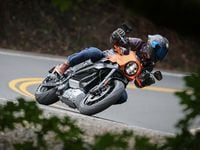It had to happen. The 116-year-old brand synonymous with thumping V-twins was bound to dip its toe into electrification, and the long-awaited 2020 Harley-Davidson LiveWire is an inevitability sure to leave the traditionalists perplexed and the futurists intrigued.
LiveWire represents a startling shift for those raised on the potato-potato thump. But in many ways this $29,799 EV is a rolling embodiment of what happens when Milwaukee traditionalists not only acknowledge the march of progress, but embrace it wholeheartedly. First and foremost, LiveWire looks like no other hog before it—a good thing, considering this is a fresh-slate opportunity if ever there was one. Rather than nostalgically hat-tipping the past or visually rehashing the V-twin glory days, the new EV offers an entirely fresh take on two-wheeled transportation. Sure, there's an obligatory false tank and a familiar bikini fairing, but the finned 15.5 kWh lithium-ion battery evokes an appropriately monolithic, brick-like form that's framed by a cast-aluminum chassis.
Stealing glances from the mostly black-anodized structure is an underslung permanent-magnet electric motor that’s shrouded in a cast-aluminum shell. Harley isn’t nicknamed The Motor Company for no reason: The powerplant is showcased with a metallic case that visually pops, in spite of its out-of-the-way placement. Situated down low for advantageous weight distribution, the motor produces 105 hp and 86 pound-feet of torque, enough to propel the 549-pound bike to 60 mph in a claimed three seconds flat.
The acceleration figure feels credible and, more importantly, easily reproducible because it takes very little technique to achieve maximum thrust. Swing a leg over the dual-seat saddle and the ergonomics come across as more upright and jaunty than most Harleys extant; think more XR1200, with its wide handlebars and slightly forward reach, than the legs-forward Dyna or V-Rod. There’s also the matter of interface, which combines some familiar switch gear like separate left and right turn signal buttons with new elements like two thumb-operated joysticks and a voice-activation button.
There’s also a 4.3-inch TFT screen, but don’t let the tech fool you; much of the LiveWire’s operation is fairly intuitively learned, despite the depth of customizability that includes individually controllable power delivery, regen levels, and throttle response settings. Although the seven modes (four of which are preset) can be easily switched on the fly via a hard button on the right grip, fine-tuning the three custom settings requires stopping the bike, disengaging the so-called propulsion mode (which is the equivalent of being “in gear”), and scrolling through a menu to set the sliders, ironically enough like an old-school audiophile graphic equalizer. Incidentally, it’s remarkably easy to hold down the TC button (just above the horn), disable the nannies, and engage in a one-handed burnout since there’s no clutch lever to go with the direct-drive, single-speed transmission.
That said, riding the LiveWire is a revelation for those steeped in internal combustion motorcycles. Roll-on throttle delivers intuitive, easy-to-control levels of power that translate to smooth, thick torque. You won’t get the initial punch of intense off-the-line acceleration you would from a big-bore V-twin, but it doesn’t take long for the electrons to accumulate and get the LiveWire shooting forward at a remarkable pace.
Get going, and the acceleration is addictive, accompanied by a faint, manufactured sound. The sonic effect lends the bike a whirring, futuristic din that’s harder to notice onboard than it is externally. More than once, I found myself rolling off the throttle and taking advantage of the regenerative braking to scrub speed off without pulling the right lever, then flicking the right grip and launching forward in a satisfying blast of (nearly silent) speed. The gap between 60 mph and 80 mph is closed in only 1.9 seconds, and while maximum speed is electronically limited to 110 mph, it feels like there’s plenty more room left to go from the motor, which can spin up to 15,000 rpm.
Showa’s Big Piston fork and BFRC-lite rear monoshock are fully adjustable, and do an admirable job of masking the LiveWire’s considerable heft. There isn’t the compliance you’ll find in a lighter-weight bike, but in a curious way the LiveWire rides much like you would expect a heavyweight Harley should, at least in a straight line: with an unwavering, authoritative presence. The surprise, however, comes on twisty roads where the EV comports itself rather nicely, shifting weight and cornering at unexpectedly high speeds.
Although not a slice-and-dice canyon carver, LiveWire still managed to unravel the twisties above Portland, Oregon, with surprising ease. Brake feel from the Brembo Monoblocks was good, and easy enough to make you forget about that whole energy-flowing-back-into-the-battery thing that happens when the stoppers are applied. LiveWire range is rated at 95 miles combined, or 146 miles if you stick to the city; based on nearly 65 miles of hard acceleration, some high-speed cruising, and a few quick smoky burnouts, we’d say those estimates are easily achieved (and, if you have the patience to ride more conservatively, surpassed).
LiveWire is equipped with an onboard DC Fast Charger capable of going from 0 to 80 percent in 40 minutes, and can also be hooked up to a standard Level 2 charger. Unfortunately however, it absorbs Level 2 chargers at Level 1 rates—meaning only 13 miles of range are added every hour, making it a painfully slow process.
While diehards will argue that Harley-Davidson’s eBike arrives several beats behind time-tested players like Zero Motorcycles—who incidentally charge less of a premium for electrification while offering greater range—the LiveWire nonetheless takes a strong stance in defense of itself. Sure it’s a pricey proposition (and the lack of Level 2 charging is a serious bummer), but it is also very a premium product with a look and feel that’s commensurate with its brand cachet.
And while The Motor Company also promises a series of other battery-powered rides including some lightweight models promising an MSRP under $1,000, the admittedly pricey LiveWire means a lot more than those conciliatory offerings. This motorcycle is disarmingly substantive, nicely finished, well-composed, and exhilarating to ride. But, most importantly, it is very much a Harley-Davidson.
- Helmet: AGV Pista GP R
- Jacket: Dainese Patina72
- Pant: Alpinestars Copper
- Gloves: Dainese Full Metal RS
- Boots: Alpinestars J-Cult
























/cloudfront-us-east-1.images.arcpublishing.com/octane/IIGGWFOTOJGB7DB6DGBXCCMTDY.jpg)
/cloudfront-us-east-1.images.arcpublishing.com/octane/QSTCM6AVEZA5JJBUXNIQ3DSOF4.jpg)
/cloudfront-us-east-1.images.arcpublishing.com/octane/U4I7G625B5DMLF2DVIJDFZVV6M.jpg)
/cloudfront-us-east-1.images.arcpublishing.com/octane/B6XD6LS6IVCQPIU6HXDJSM3FHY.jpg)
/cloudfront-us-east-1.images.arcpublishing.com/octane/ICL63FEDDRDTTMINYICCEYGMDA.jpg)
/cloudfront-us-east-1.images.arcpublishing.com/octane/FCGZHQXRBZFLBAPC5SDIQLVF4I.jpg)
/cloudfront-us-east-1.images.arcpublishing.com/octane/WNOB6LDOIFFHJKPSVIWDYUGOPM.jpg)

/cloudfront-us-east-1.images.arcpublishing.com/octane/X33NU3E525ECRHXLNUJN2FTRKI.jpg)
/cloudfront-us-east-1.images.arcpublishing.com/octane/6KKT5NNL2JAVBOXMZYS5ZO76YA.jpg)
/cloudfront-us-east-1.images.arcpublishing.com/octane/J5RKG5O455GMPGQRF2OG6LRT7A.jpg)
/cloudfront-us-east-1.images.arcpublishing.com/octane/GX2CIZKQVRH2TATDM26KFG2DAE.jpg)
/cloudfront-us-east-1.images.arcpublishing.com/octane/ZWIDYSAKQZHD5BHREMQILXJCGM.jpg)
/cloudfront-us-east-1.images.arcpublishing.com/octane/CYUHJZCTSJCH3MRAQEIKXK7SCQ.jpg)
/cloudfront-us-east-1.images.arcpublishing.com/octane/LKOFINY56FCXJCANJ5M7ZDQUBY.jpg)
/cloudfront-us-east-1.images.arcpublishing.com/octane/4NBPDACMWJH63JQYJVK3QRBDZI.jpg)
/cloudfront-us-east-1.images.arcpublishing.com/octane/KKHQHRR3FJGX7H2IPU6RALMWG4.jpg)

/cloudfront-us-east-1.images.arcpublishing.com/octane/5IOFS5JAE5FOXMNA23ZRAVVYUU.jpg)
/cloudfront-us-east-1.images.arcpublishing.com/octane/CGXQ3O2VVJF7PGTYR3QICTLDLM.jpg)

/cloudfront-us-east-1.images.arcpublishing.com/octane/OQVCJOABCFC5NBEF2KIGRCV3XA.jpg)
/cloudfront-us-east-1.images.arcpublishing.com/octane/OPVQ7R4EFNCLRDPSQT4FBZCS2A.jpg)
/cloudfront-us-east-1.images.arcpublishing.com/octane/YBPFZBTAS5FJJBKOWC57QGEFDM.jpg)